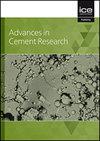Potential of NaCl solution as mixing water in siliceous minerals modified calcium aluminate cement
IF 1.3
4区 工程技术
Q3 CONSTRUCTION & BUILDING TECHNOLOGY
引用次数: 0
Abstract
Given the advantages of calcium aluminate cement (CAC) in specific marine engineering, selecting materials directly from the sea when mixing CAC can cut down the construction costs and reduce the ecological pollution to the sea. However, the investigation of using seawater as the mixing water of CAC is still trekking with difficult on account of the strength reduction. In this regard, this paper evaluated the possibility of using NaCl solution as mixing water and diatomite as SCMs to modify CAC. Silica fume (SF) and the corrosion by immersion in NaCl solution is employed as the reference. The strength, mass, and length changes of CAC mortars at both 20 °C and 40 °C were tested, and the phase assemblages and morphology were characterized by XRD, TG-DSC and SEM. Results reveal that using NaCl solution as the mixing water is beneficial to the later strength development of CAC, which promotes the formation of C2ASH8 in CAC pastes and exhibits no strength retraction even at 40 °C. The strength of the diatomite/SF modified CAC mortars mixing with NaCl solution is all higher than that immersed in NaCl solution. By contrast, the cooperation effect of diatomite and NaCl solution can significantly increase the strength of CAC, especially at 20 °C. And diatomite favors strength development of CAC mortars, while SF contributes to a better mass and length stability.氯化钠溶液在硅质矿物改性铝酸钙水泥中的混水潜力
鉴于铝酸钙水泥(CAC)在特定海洋工程中的优势,在混合CAC时直接从海洋中选择材料可以降低施工成本,减少对海洋的生态污染。然而,由于强度降低,使用海水作为CAC的混合水的研究仍然举步维艰。在这方面,本文评估了使用NaCl溶液作为混合水和硅藻土作为SCMs来改性CAC的可能性。采用硅灰(SF)和浸泡在NaCl溶液中的腐蚀作为参考。测试了CAC浆料在20°C和40°C下的强度、质量和长度变化,并通过XRD、TG-DSC和SEM对相组合和形态进行了表征。结果表明,使用NaCl溶液作为混合水有利于CAC后期的强度发展,促进了CAC浆体中C2ASH8的形成,即使在40°C时也不会出现强度收缩。硅藻土/SF改性CAC砂浆与NaCl溶液混合后的强度均高于浸泡在NaCl溶液中的强度。相比之下,硅藻土和NaCl溶液的协同作用可以显著提高CAC的强度,尤其是在20°C时。硅藻土有利于CAC砂浆的强度发展,而SF有助于更好的质量和长度稳定性。
本文章由计算机程序翻译,如有差异,请以英文原文为准。
求助全文
约1分钟内获得全文
求助全文
来源期刊

Advances in Cement Research
工程技术-材料科学:综合
CiteScore
3.70
自引率
5.00%
发文量
56
审稿时长
3.2 months
期刊介绍:
Advances in Cement Research highlights the scientific ideas and innovations within the cutting-edge cement manufacture industry. It is a global journal with a scope encompassing cement manufacture and materials, properties and durability of cementitious materials and systems, hydration, interaction of cement with other materials, analysis and testing, special cements and applications.
 求助内容:
求助内容: 应助结果提醒方式:
应助结果提醒方式:


